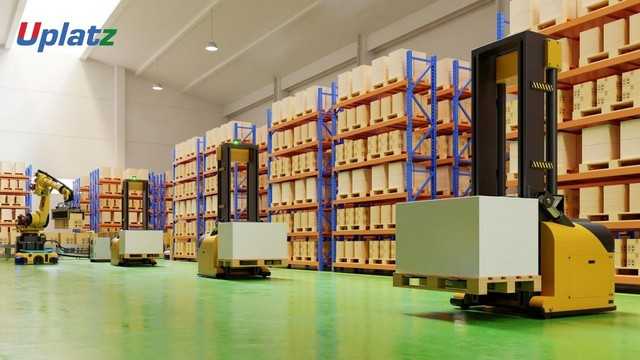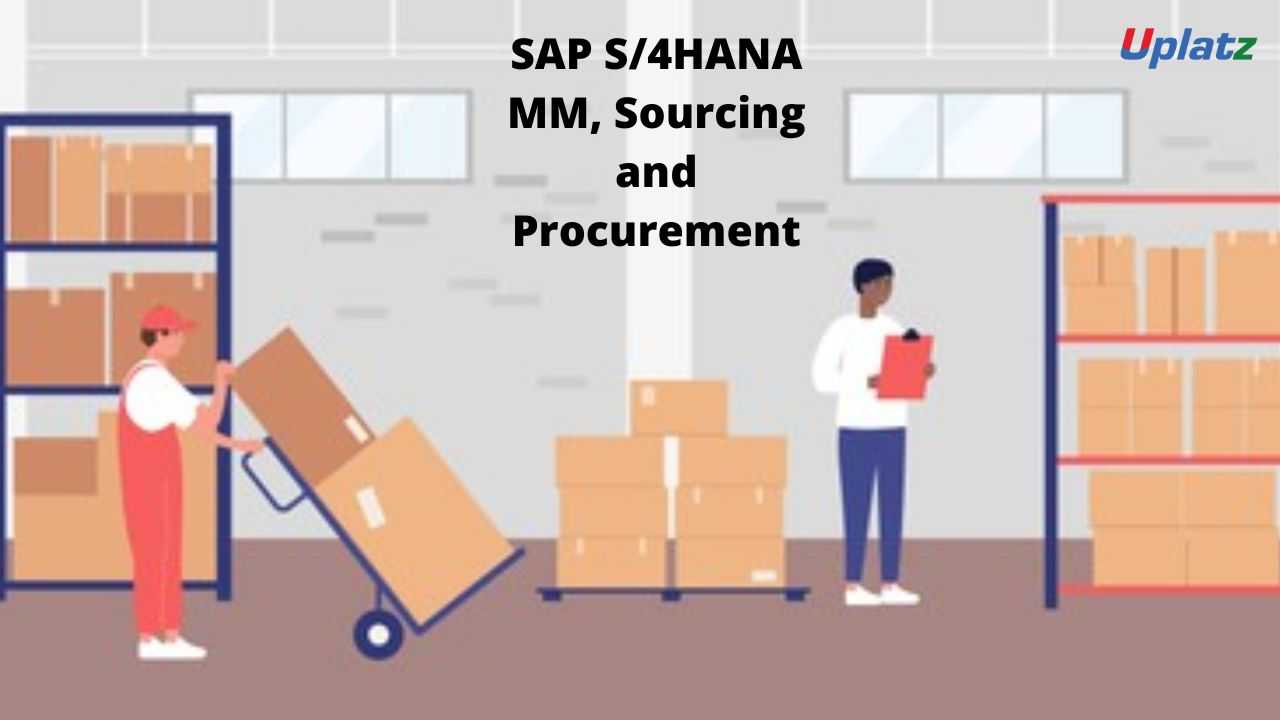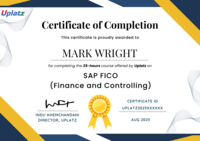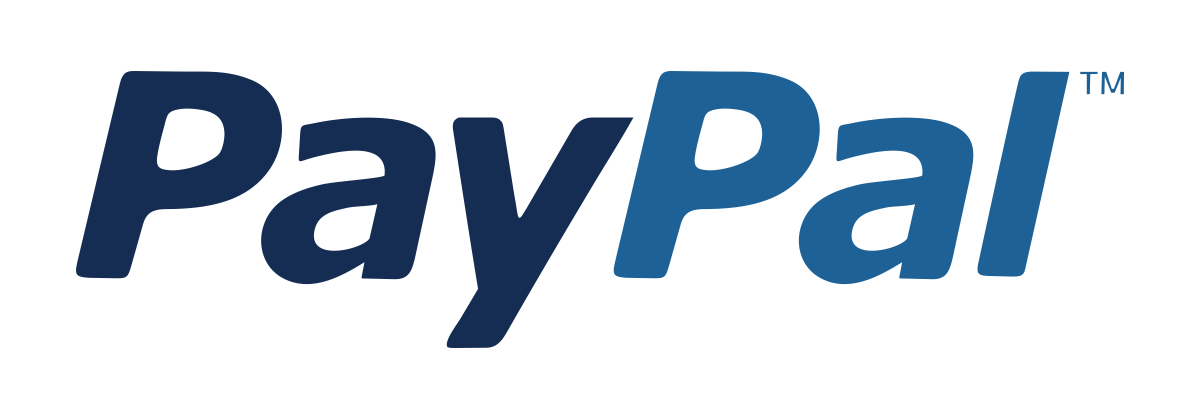Bundle Combo - SAP S/4HANA Sales and S/4HANA Logistics
SAP S/4HANA Sales: Efficient Sales Processes & Customer Engagement. SAP S/4HANA Logistics: Streamlining Supply Chain Operations & Inventory ManagementPreview Bundle Combo - SAP S/4HANA Sales and S/4HANA Logistics course
Price Match Guarantee Full Lifetime Access Access on any Device Technical Support Secure Checkout Course Completion Certificate 92% Started a new career
BUY THIS COURSE (
92% Started a new career
BUY THIS COURSE (GBP 22 GBP 49 )-
 96% Got a pay increase and promotion
96% Got a pay increase and promotion
Students also bought -
-

- Career Path - SAP Functional Consultant
- 500 Hours
- GBP 99
- 7893 Learners
-

- SAP S/4HANA EWM 1909
- 36 Hours
- GBP 12
- 247 Learners
-

- SAP S/4HANA MM Sourcing and Procurement
- 30 Hours
- GBP 12
- 449 Learners

Uplatz provides this bundle combo of courses on
1).SAP S/4HANA Sales
2).SAP S/4HANA Logistics
SAP S/4HANA Sales is a component of the SAP S/4HANA ERP (Enterprise Resource Planning) system, which is designed to streamline and optimize sales processes within an organization. It offers a range of features and functionalities to help businesses manage their sales activities effectively.
Here are some key features and capabilities of SAP S/4HANA Sales:
1).Sales Order Management: SAP S/4HANA Sales allows businesses to create, process, and track sales orders. It provides tools for order entry, order confirmation, availability checks, pricing, and credit management.
2).Pricing and Discounts: The system enables businesses to define and manage complex pricing structures, discounts, promotions, and pricing conditions. It supports different pricing strategies and allows for automatic calculation of prices based on predefined rules.
3).Customer Relationship Management (CRM): SAP S/4HANA Sales integrates with SAP CRM functionality to provide comprehensive customer relationship management capabilities. It helps businesses manage customer data, track interactions, and analyze customer behavior to improve sales and customer service.
4).Inventory Management: The solution offers real-time visibility into inventory levels and supports inventory management processes. It helps businesses optimize stock levels, track goods movements, and manage replenishment and fulfillment processes.
5).Sales Analytics: SAP S/4HANA Sales provides powerful analytics and reporting capabilities, allowing businesses to gain insights into sales performance, customer behavior, and market trends. It offers pre-built dashboards and reports, as well as ad-hoc reporting capabilities.
6).Mobile Sales: The system supports mobile sales capabilities, enabling sales representatives to access relevant sales information, process orders, and interact with customers while on the go. It helps improve productivity and responsiveness.
7).Integration and Extensibility: SAP S/4HANA Sales integrates with other modules within the SAP S/4HANA suite, such as finance, logistics, and production, providing end-to-end business process integration. It also offers extensibility options to customize and adapt the system to specific business requirements.
Overall, SAP S/4HANA Sales is designed to enhance sales effectiveness, improve customer engagement, and drive revenue growth by streamlining sales processes, enabling better decision-making, and providing a holistic view of sales operations.
SAP S/4HANA Logistics is a module within the SAP S/4HANA ERP (Enterprise Resource Planning) system that focuses on managing and optimizing logistics and supply chain operations. It provides a comprehensive set of functionalities to streamline and automate processes related to procurement, inventory management, production planning, and logistics execution.
Here are some key features and capabilities of SAP S/4HANA Logistics:
1).Procurement: SAP S/4HANA Logistics enables businesses to manage the procurement process efficiently. It supports supplier management, purchase requisitions, purchase orders, request for quotations (RFQs), and invoice verification. It also offers features for supplier evaluation and strategic sourcing.
2).Inventory Management: The system provides real-time visibility into inventory levels, allowing businesses to optimize stock levels, track goods movements, and manage inventory across multiple locations. It includes features such as goods receipt, goods issue, stock transfers, physical inventory, and batch management.
3).Material Requirements Planning (MRP): SAP S/4HANA Logistics incorporates MRP capabilities to help businesses plan and manage their material requirements. It analyzes demand, inventory levels, and lead times to generate procurement proposals and ensure optimal stock availability while minimizing excess inventory.
4).Warehouse Management: The solution supports warehouse management processes, including inbound and outbound logistics, storage bin management, picking, packing, and shipping. It provides tools for optimizing warehouse layouts, managing storage bins, and tracking goods movements.
5).Production Planning: SAP S/4HANA Logistics includes production planning features to help businesses manage their manufacturing processes effectively. It supports capacity planning, bill of materials (BOM), work center management, production orders, and shop floor control. It enables businesses to schedule and monitor production activities, optimize resources, and ensure timely delivery.
6).Transportation Management: The system offers transportation management capabilities, allowing businesses to plan, execute, and monitor transportation activities. It supports freight order management, carrier selection, route optimization, shipment tracking, and freight cost calculation.
7).Analytics and Reporting: SAP S/4HANA Logistics provides powerful analytics and reporting capabilities, enabling businesses to gain insights into their logistics operations. It offers pre-built dashboards and reports, as well as ad-hoc reporting capabilities to support data-driven decision-making.
8).Integration and Extensibility: SAP S/4HANA Logistics integrates with other modules within the SAP S/4HANA suite, such as sales, finance, and manufacturing, providing end-to-end visibility and process integration. It also offers extensibility options to customize and adapt the system to specific business requirements.
Overall, SAP S/4HANA Logistics helps businesses optimize their supply chain operations, enhance efficiency, reduce costs, and improve customer satisfaction. It provides a centralized platform for managing and controlling logistics processes, enabling businesses to make informed decisions and respond quickly to changing market demands.
Course/Topic 1 - SAP S/4HANA SD (Sales and Distribution) - all lectures
-
In this session, we learn about how SAP S/4HANA SD is different from SAP SD on ECC.
-
In this session, we learn about defining Company, Company Code, Sales Organization, Distribution Channel, Division, Sales Office and Sales Group.
-
In this session, we learn about defining Plant, Storage Location, Shipping Point and assignments of Organizational Units.
-
In this session, we learn about remaining assignments of Organizational Units.
-
In this session we learn assigning Company Code to Fiscal Year Variant, Chart of Accounts and Field Status Variant, Materials Management View on Accounting, Stochoistic Block Values, set Company Code Productive, Financial Management Area, Global Company Code, Cost of Sales Accounting, Taxes, Credit Control Area, Controlling Area and Profit Center.
-
In this session, we learn about Credit Segment, Company Code groups, FM account assignment derivation, Settings for Company Code, Material Ledger and Quantity and Value Updating.
-
In this session, we learn about Business Area, Valuation Grouping Code, Inventory Management, Plant Parameters and Maintenance Planning Plant.
-
In this session, we learn about different views of Material Master like Basic Data 1, Sales org1, Sales: General Plant, Purchasing, MRP 1, MRP 2, MRP 3, MRP 4 and Accounting 1.
-
In this session , we learn about creation of Material Master, Initial entry of Material Stock and Display of Material Stock.
-
In this session, we learn about General Data, Company Code Data, Sales Area Data and Customer account group.
-
In this session, we learn about creation of grouping, Partner Functions and Creation of Customer Master.
-
In this session, we learn about Access Sequence, Condition Type and Pricing Procedure.
-
In this session, we learn about Pricing Determination and creation of Condition Master.
-
In this session, we learn about various fields in Sales Document Type.
-
In this session, we learn about Inquiry, Quotation, Sales Order, Delivery, Transfer Order, PGI, Invoice, Credit Memo Request, Debit Memo Request, Rush Order, Cash Sales, Quantity Contract, Scheduling Agreement, Consignment Fill Up, Consignment Issue, Consignment Pick Up and Consignment Return.
-
Episode 16 - Item Category Type
-
In this session, we learn about Configuration of Cross Selling.
-
In this session, we learn about Configuration of Free Goods.
-
In this session, we learn about Configuration of Third Party Sales.
-
In this session, we learn about Copy Control, Product Proposal, Material Exclusion, Material Determination, Picking and Confirmation, Billing Document types, Creation of Billing Documents, Billing Methods, Billing Plan, Types of Billing Plan, Revenue Account Determination, Credit Management, Output Determination Process and Partner Determination.
-
In this session, we learn about ASAP Methodology for Implementation Project and Support Project.
Course/Topic 2 - SAP S/4HANA Logistics course - all lectures
-
In this video, you will be introduced to SAP S/4HANA, where it started and where it is now. You will be also introduced to what was the sudden need for SAP to look at the new product launch and how data plays an important role in that. You will also learn the challenges faced by the IT & businesses and what were the pain points.
-
In the session, you will have a deeper knowledge of the evolution of S/4HANA from 1973 to till now. You will be introduced to four sets of services offered in SAP S/4HANA. Further, you will be preceded with what are the differences in old and new way data analytics technology. You will also learn about the user experience.
-
In this video, you will be introduced to SAP Fiori Apps types, core functions of SAP S/4HANA and its business scope. You will also learn about the new improved functionality of S/4 HANA, i.e. system data module and user experience. Further, you will be preceded with principles of S/4 HANA.
-
In this video, you will learn about the direct path of SAP S/4HANA master data, how SAP S/4HANA handles material requirement planning and material shortage. You will also learn about sourcing and procurement business scenario with and without HANA. Further, you will be preceded with supply chain management integrated with SAP S/4HANA.
-
In the session, you will be presented with the detailed explanation of, in which cases; any customer would like to go for conversion or implementation. In the SAP S/4HANA, there are two types of implementation, about which you will be explained in detail along with their framework. You will also learn about the evolution of customer code checks.
-
In this video, you will learn how SAP started functioning using ASAP methodology and its five cases. You will also learn about the innovation adoption framework for SAP S/4HANA and how to deploy it with SAP activate. Further, you will be preceded with best practices for SAP S/4HANA followed by some examples.
-
This session covers all the basics that had been covered till now. You will be presented with the basic of SAP S/4HANA and a detailed explanation of the path that HANA has covered from 1973 to 2015.
-
In this video, you will learn how SAP S/4HANA is different from ECC and the changes that have been done in SAP S/4HANA. Further, you will be preceded by a detailed explanation of SAP S/4HANA material and operations management. You will also be introduced to the basics of business partner and SAP EWM.
-
In this video, you will learn about Hana Modeler, what are the views, analytics, etc. You will also learn how it is used to create all info views on schemas & tables on HANA database. Further, you will be introduced to dimensions & measures, Schemas, snow flex schema, galaxy schema and data modelling. You will also learn about the licensing of HANA and its two types.
-
In the session, you will have a deeper knowledge of SAP Fiori - an integral part of SAP S/4HANA. You will also learn how it has been aligned to all the businesses and what Fiori apps library is. Further, you will be preceded with the architecture in which Fiori works, SAP net weaver gateway and how they do configuration for the set up.
-
In this video, you will be presented with a detailed explanation of SAP HANA architecture, what are the CDS views, how the architecture is structured and analytics part of it. You will also learn about, what the things that additional are helping in and how the entire set up brought in to front in.
-
In this video, you will learn about the business partner and how they are able to centrally manage data. You will also learn about what were the limitations in tradition system. Further, you will be preceded with different categories of business partner and how to create it followed by their respective configuration.
-
In this video, you will have a deeper knowledge of the configuration of a business partner, where you’ll have a customer, vendor and you will also learn how the customer gets triggered in term of the business partner. Further, you will have an understanding of how business partners work and configuration behind the contact person.
-
In this video, you will be presented with steps to determine address type, how to maintain the tax number categories in the business partner and where will it be stored. Further, you will have a detailed explanation on why we create a master data governance and how it will be implemented in an SAP S/4HANA.
-
In this video, you will learn about how credit management actually works. How it is managed by the credit control area, what are credit checks and its types? Further, you will also learn how a business partner is aligned to credit management in SAP S/4HANA set up. You will also learn the configuration of credit management.
-
In this video, you will learn about the three types of sales document: Header, Item, Schedule. You will be presented with what are the configurations behind item category, schedule category and sales document types.
-
This video is in continuation with the previous lecture on how to determine all the delivery date and confirm the quantity with the help of delivery schedules. You will be introduced to pick/pack time, i.e. shipping point followed by its configuration. Further, you will be introduced to loading time, transportation time and transit time in delivery schedule.
-
In this video, you will learn about product allocation and its configuration, how to activate product allocation and the three different set up for the product allocation. Further, you will be preceded with the configuration of product allocation object. You will also learn about the AATP system, AATP back order processing.
-
In this video, you will learn what rebate agreement is and its configuration path in ECC set up and about the 3 processes where rebate activation takes place along with their configuration. You will also learn about transaction WCOCO where you can create a conditional contract.
-
In this video, you will be presented with the configuration of rebate settlement in SAP S/4HANA followed by several steps. You will also learn the configuration of condition contract types, settlement process types, settlement doc type and many more.
-
This video is all about the questions put up by students and clearing the doubts on the SAP S/4HANA module.
-
In this video, you will learn what BRFplus is, how it is managed and who operates it. You will also learn about the types of a business rule is and how rules are represented in a system. Further, you will be preceded by how to create a business rule set up based on BRFplus followed by the configuration.
-
In this video, questions are put up by students regarding what Form templates is, how it gets assigned to the output type and the application and steps to follow the configuration. You will also learn about the combination required for a system to show the output.
-
In this video, you will learn about what was the need for SAP S/4HANA to come out with changes in sourcing and procurement. You will also learn about Ariba integration and what supply life cycle management is and its code deployment. Further, you will be preceded by how to create purchase requisitions followed by several steps along with their respective configuration.
-
In the session, you will learn about the changes that have been done in master data in the SAP S/4HANA system. You will be introduced to four types of master data and changes that took place in a business partner. Further, you will be preceded with the steps to follow partner determination.
-
In this video, you will be presented with the configuration on the procurement side required from the logistics consultant perspective. You will also learn what material type is, things that are determined through material type and its configuration. Further, you will be preceded with a detailed explanation on the quality/value updating, valuation class and many more. You will also learn about the configuration of purchase requisition, RFQ and master data set up.
-
In this video, you will learn about the purchase order set up and the different types of procurement type in the purchase order. Further, you will be preceded by the steps to follow the configuration of a purchase order from setting a tolerance limit to the release process. You will also learn the inventory base configuration as well.
-
In the session, you will learn how automatically create storage location, screen layout, etc. you will also learn about the account determination and the steps to follow the configuration, i.e. valuation class, valuation group code, valuation area, company code and many more. Further, you will have an understanding of the differences between stock transfer and transfer posting.
-
In this video, you will have a deeper knowledge of what material ledger is, why it has been not used in ECC system and what changes have been introduced in a material ledger in SAP S/4HANA. You will have a detailed explanation of three functionalities of material ledger, i.e., multiple currencies, multiple valuations and actual costing.
-
This video is a continuation of the first part where you will have a deeper understanding of benefits of using the Actual costing in an SAP S/4HANA. Further, you will be preceded by steps to customize material ledger and how splits the cost of goods.
-
In the session, you will be introduced to Material Requirements Planning (MRP), why it is required and its importance in SAP S/4HANA. You will learn about the dependent and independent demand, lot sizing and how MRP runs in the system. Further, you will be preceded with master data and three different types of MRP procedure. You will also learn the configuration of the above mentioned process.
-
In this video, you will learn how to activate MRP & planning file entries in the SAP S/4HANA system. You will also learn about the factors that influence MRP. Further, you will be preceded by a detailed explanation of what are planned order, production order and process order along with their respective configuration.
-
In the session, you will be presented with the configuration of production planning for process industries and how MRP and PPPI are integrated into a system.
-
In this video, you will have deeper knowledge of five parameters on which MRP logic works, i.e. material calculation, lot sizing, production type, scheduling & BOM explosion. You will also learn how product version has become mandatory in SAP S/4HANA and the changes that have been done in the new system.
The course objectives of an SAP S/4HANA Sales course may vary depending on the specific training provider or program. However, generally speaking, the course aims to provide participants with a comprehensive understanding of the sales functionalities and capabilities of the SAP S/4HANA Sales module. Some common course objectives may include:
1).Understanding SAP S/4HANA Sales: Gain a thorough understanding of the features, architecture, and components of the SAP S/4HANA Sales module.
2).Mastering Sales Processes: Learn how to configure and execute end-to-end sales processes, including sales order management, pricing, billing, and customer relationship management (CRM).
3).Configuring Sales Document Types: Acquire the knowledge and skills to create and customize different types of sales documents, such as sales orders, quotations, contracts, and returns.
4).Pricing and Discounts: Explore the pricing functionality in SAP S/4HANA Sales, including price determination, condition technique, pricing procedures, and discounts.
5).Customer Relationship Management: Understand the CRM capabilities of SAP S/4HANA Sales, including customer master data management, account management, lead and opportunity management, and sales analytics.
6).Integration with Other Modules: Learn about the integration points between SAP S/4HANA Sales and other SAP modules like Finance (FI), Materials Management (MM), and Production Planning (PP).
7).Reporting and Analytics: Discover how to use reporting and analytics tools in SAP S/4HANA Sales to generate sales reports, analyze sales data, and monitor key performance indicators (KPIs).
8).Hands-on Practice: Gain practical experience through hands-on exercises and simulations to reinforce theoretical knowledge and develop proficiency in using SAP S/4HANA Sales.
9).Best Practices and Industry Insights: Explore industry-specific best practices and gain insights into how SAP S/4HANA Sales can be effectively utilized to optimize sales processes and achieve business goals.
10).Certification Preparation (Optional): Prepare for SAP S/4HANA Sales certification exams, if applicable, by covering the required topics and understanding the exam structure and format.
These objectives provide a general overview, and the actual course content and objectives may vary. It's advisable to review the specific course syllabus or outline provided by the training provider for more detailed information.
The course objectives of an SAP S/4HANA Logistics course may vary depending on the specific training provider or program. However, generally speaking, the course aims to provide participants with a comprehensive understanding of the logistics functionalities and capabilities of the SAP S/4HANA system. Some common course objectives may include:
1).Understanding SAP S/4HANA Logistics: Gain a thorough understanding of the features, architecture, and components of the SAP S/4HANA Logistics module.
2).Mastering Logistics Processes: Learn how to configure and execute end-to-end logistics processes, including procurement, inventory management, production planning, warehouse management, and transportation management.
3).Configuring Master Data: Acquire the knowledge and skills to set up and maintain master data relevant to logistics processes, such as material master data, vendor master data, and customer master data.
4).Procurement Processes: Learn about the procurement process in SAP S/4HANA Logistics, including purchase requisitions, purchase orders, goods receipt, invoice verification, and vendor evaluation.
5).Inventory Management: Understand the inventory management functionalities in SAP S/4HANA Logistics, including stock movements, goods issue, goods receipt, stock transfers, and physical inventory.
6).Production Planning: Explore the production planning functionalities in SAP S/4HANA Logistics, including production orders, bill of materials (BOM), routing, capacity planning, and production execution.
7).Warehouse Management: Learn about the warehouse management capabilities in SAP S/4HANA Logistics, including warehouse structure, goods receipt, goods issue, picking strategies, putaway strategies, and stock management.
8).Transportation Management: Understand the transportation management functionalities in SAP S/4HANA Logistics, including transportation planning, carrier selection, route determination, freight cost calculation, and shipment tracking.
9).Integration with Other Modules: Learn about the integration points between SAP S/4HANA Logistics and other SAP modules like Finance (FI), Sales and Distribution (SD), and Production Planning (PP).
10).Reporting and Analytics: Discover how to use reporting and analytics tools in SAP S/4HANA Logistics to generate logistics reports, monitor key performance indicators (KPIs), and analyze logistics data.
11).Hands-on Practice: Gain practical experience through hands-on exercises and simulations to reinforce theoretical knowledge and develop proficiency in using SAP S/4HANA Logistics.
12).Best Practices and Industry Insights: Explore industry-specific best practices and gain insights into how SAP S/4HANA Logistics can be effectively utilized to optimize logistics processes and achieve business goals.
13).Certification Preparation (Optional): Prepare for SAP S/4HANA Logistics certification exams, if applicable, by covering the required topics and understanding the exam structure and format.
These objectives provide a general overview, and the actual course content and objectives may vary. It's advisable to review the specific course syllabus or outline provided by the training provider for more detailed information.
Course Syllabus: SAP S/4HANA Sales and Logistics
Module 1: Introduction to SAP S/4HANA
a).Overview of SAP S/4HANA
b).Differences between SAP ECC and S/4HANA
c).Key Features and Benefits
d).System Architecture
Module 2: SAP S/4HANA Sales
1)-Sales Organization Structure
a).Sales Area Concept
b).Organizational Units
c).Master Data Overview
2).Sales Order Management
a).Creating Sales Orders
b).Order Types and Processes
c).Availability Check and Backorder Processing
3).Pricing and Conditions
a).Condition Technique
b).Pricing Procedures
c).Discounts and Surcharges
4).Delivery and Shipping
a).Delivery Processes
b).Shipping Points and Routes
c).Picking, Packing, and Goods Issue
5).Billing and Invoicing
a).Invoice Creation and Types
b).Credit Management
c).Integration with Financial Accounting
6).Reporting and Analytics
a).Sales Order Reporting
b).Key Performance Indicators
c).Using SAP Fiori for Sales Analytics
Module 3: SAP S/4HANA Logistics
1).Logistics Overview
a).Overview of Logistics in S/4HANA
b).Integration with Other Modules
2).Inventory Management
a).Stock Management Concepts
b).Goods Movements and Inventory Valuation
c).Physical Inventory Process
3).Warehouse Management
a).Warehouse Structure and Processes
b).Inbound and Outbound Processes
c).Warehouse Control and Optimization
4).Procurement Process
a).Purchase Requisitions and Orders
b).Goods Receipt and Invoice Verification
c).Supplier Management
5).Production Planning and Control
a).Production Order Management
b).Capacity Planning and Scheduling
c).Integration with Sales and Procurement
6).Reporting and Analytics
a).Logistics Reporting Tools
b).Using SAP Fiori for Logistics Insights
c).Data Analysis and Key Metrics
Module 4: Integration and Advanced Topics
a).Integration between Sales and Logistics
b).Managing Cross-Functional Processes
c).SAP S/4HANA Cloud vs. On-Premise Solutions
d).Future Trends in SAP S/4HANA
Module 5: Hands-On Practice
a).Case Studies and Real-World Scenarios
b).System Configuration Exercises
c).Simulations of Sales and Logistics Processes
Module 6: Project Work
a).Group Project: End-to-End Sales and Logistics Scenario
b).Presentation of Findings and Solutions
c).Peer Review and Feedback
Additional Resources
a).Recommended Reading and Online Resources
b).SAP Community and Support Forums
c).Certification Pathways and Exam Preparation
Assessment
a).Quizzes and Assignments after Each Module
b).Final Project Presentation
c).Certification Exam Preparation
SAP S/4HANA is a comprehensive suite of enterprise resource planning (ERP) applications that includes modules for Sales and Logistics. Certifications in these areas are highly valuable for professionals looking to validate their expertise and advance their careers in SAP environments. Here are some of the top certifications for SAP S/4HANA Sales and Logistics, along with their benefits:
1).Top Certifications in SAP S/4HANA Sales SAP Certified Application Associate - SAP S/4HANA Sales (S4H00)
a).Overview: This certification focuses on foundational knowledge and skills needed to work with SAP S/4HANA Sales. It covers core concepts, configuration, and functionalities related to the Sales and Distribution (SD) module.
b).Benefits: Core Knowledge Validation: Confirms your understanding of the core functionalities and processes in SAP S/4HANA Sales. Career Advancement: Enhances your credentials for roles such as SAP Sales Consultant or SAP Sales Analyst.
c).Industry Recognition: Provides a well-recognized certification that is valued by employers for its comprehensive coverage of SAP S/4HANA Sales functionalities.
2).SAP Certified Application Associate - SAP S/4HANA Sales Order Processing (C_S4CS_2308)
a).Overview: This certification focuses on order processing within the SAP S/4HANA Sales module, including sales order management, delivery processing, and billing.
b).Benefits: Specialized Expertise: Demonstrates deep knowledge of sales order processing and related transactions in SAP S/4HANA.
c).Professional Growth: Positions you for specialized roles in sales order management and processing within SAP environments.
d).In-Demand Skills: Addresses specific needs in sales order management, making you a valuable asset to organizations using SAP S/4HANA.
3).SAP Certified Application Associate - SAP S/4HANA Sales 2024 (C_S4CPS_2024)
a).Overview: This certification focuses on the latest features and capabilities of SAP S/4HANA Sales as of the 2024 release. It covers updates and new functionalities in sales processes.
b).Benefits: Up-to-Date Knowledge: Ensures you are knowledgeable about the latest updates and functionalities in SAP S/4HANA Sales. Career Relevance: Enhances your marketability and effectiveness in roles requiring up-to-date SAP S/4HANA Sales skills. Advanced Proficiency: Positions you as an expert in the latest SAP S/4HANA Sales features and capabilities.
Top Certifications in SAP S/4HANA Logistics SAP Certified Application Associate -
4).SAP S/4HANA Cloud - Supply Chain Management (C_S4CS_2022)
a).Overview: This certification focuses on the supply chain management capabilities of SAP S/4HANA Cloud, including procurement, inventory management, and production planning. Benefits: Cloud Expertise: Validates your skills in managing supply chain processes within the SAP S/4HANA Cloud environment. Career Opportunities: Positions you for roles in supply chain management with a focus on cloud-based solutions.
b).Current Trends: Addresses the increasing shift towards cloud-based SAP solutions, making you more relevant in the industry.
5).SAP Certified Application Associate - SAP S/4HANA Production Planning and Manufacturing (C_S4PP_2308)
a).Overview: This certification focuses on production planning and manufacturing processes within SAP S/4HANA, covering topics such as production orders, material requirements planning (MRP), and manufacturing execution.
b).Benefits: Specialized Knowledge: Confirms your expertise in production planning and manufacturing processes within SAP S/4HANA. Career Growth: Enhances your qualifications for roles in production planning, manufacturing, and supply chain management.
c).Industry Demand: Provides in-depth knowledge that is highly relevant for organizations using SAP S/4HANA for manufacturing processes.
6).SAP Certified Application Associate - SAP S/4HANA Logistics (C_S4LMS_2024)
a).Overview: This certification covers a broad range of logistics processes within SAP S/4HANA, including procurement, inventory management, and logistics execution.
b).Benefits: Comprehensive Coverage: Validates your overall knowledge of logistics processes and functionalities in SAP S/4HANA.
c).Versatile Role: Positions you for various roles in logistics, supply chain management, and operations within SAP environments.
d).Professional Recognition: Provides a well-rounded certification that enhances your credibility and career prospects in SAP S/4HANA Logistics.
7).SAP Certified Application Associate - SAP S/4HANA Asset Management (C_S4AM_2023)
a).Overview: Focuses on asset management processes within SAP S/4HANA, including maintenance planning, execution, and asset performance management.
b).Benefits: Asset Management Expertise: Confirms your ability to manage and optimize asset-related processes in SAP S/4HANA.
c).Specialized Roles: Positions you for roles in asset management and maintenance within SAP environments.
d).Industry Value: Provides a specialized credential that addresses the specific needs of asset management in modern enterprises.
Each of these certifications offers unique benefits and can significantly enhance your career by validating your skills and knowledge in SAP S/4HANA Sales and Logistics. They cater to different aspects of SAP S/4HANA's capabilities, from general sales and logistics functionalities to specialized areas like production planning and asset management.
After completing a course bundle combo focusing on SAP S/4 HANA Sales and SAP S/4 HANA Logistics, individuals can pursue various specialized roles within the field of SAP and enterprise resource planning (ERP) systems. Here are typical job roles and potential salary ranges associated with these certifications:
SAP S/4 HANA Consultant - Salaries for SAP consultants can vary widely based on experience and location. On average, SAP consultants specializing in S/4 HANA modules can earn between $80,000 to $150,000 per year.
SAP Functional Analyst (Sales & Logistics) - Salaries for SAP functional analysts typically range from $70,000 to $120,000 annually.
SAP Project Manager (S/4 HANA) - Salaries for SAP project managers can range from approximately $90,000 to $160,000 per year.
SAP Business Analyst (Sales & Logistics) - Salaries for SAP business analysts specializing in Sales and Logistics modules typically range from $75,000 to $130,000 annually.
SAP Functional Consultant (Sales & Logistics) - Salaries for SAP functional consultants can vary based on specialization and industry demand. Generally, salaries range from $80,000 to $140,000 per year .
SAP Solution Architect (Sales & Logistics) - Salaries for SAP solution architects typically range from $100,000 to $180,000 per year.
These salary ranges are approximate and can vary based on factors such as geographic location, industry sector (manufacturing, retail, consulting), specific SAP certifications, years of relevant experience, and additional skills such as project management or specific industry knowledge. Advanced certifications, continuous professional development, and hands-on experience with SAP S/4 HANA implementations can further enhance career prospects and earning potential in the SAP ecosystem.
Here are top interview questions and answers for SAP S/4HANA Sales and SAP S/4HANA Logistics modules. These interview questions and answers provide a starting point for preparing for interviews on SAP S/4HANA Sales and SAP S/4HANA Logistics. However, it's essential to thoroughly understand the concepts, processes, and functionalities of these modules to be well-prepared for interviews.
SAP S/4HANA Sales Module
Q1: What is the significance of the SAP S/4HANA Sales module?
Answer: The SAP S/4HANA Sales module is responsible for managing sales processes, such as creating sales orders, pricing, billing, and customer relationship management (CRM) activities.
Q2: How can you create a sales order in SAP S/4HANA Sales?
Answer: Sales orders can be created in SAP S/4HANA Sales using transaction code VA01 or through the Sales Order Creation process in the SAP Fiori user interface.
Q3: What is the purpose of pricing in SAP S/4HANA Sales?
Answer: Pricing in SAP S/4HANA Sales determines the calculation of prices for products and services based on various factors like customer-specific conditions, discounts, and surcharges.
Q4.How can you determine the availability of stock for a product in SAP S/4HANA Sales?
Answer: Stock availability in SAP S/4HANA Sales can be checked using the transaction code CO09 or through the Stock Availability Overview in the SAP Fiori user interface.
Q5. Explain the concept of delivery scheduling in SAP S/4HANA Sales.
Answer: Delivery scheduling in SAP S/4HANA Sales involves determining the earliest and latest possible delivery dates for a sales order based on the availability of stock and transportation planning.
Q6.How can you create a billing document in SAP S/4HANA Sales?
Answer: Billing documents can be created in SAP S/4HANA Sales using transaction code VF01 or through the Billing process in the SAP Fiori user interface.
Q7.What is the purpose of the SAP CRM integration with SAP S/4HANA Sales?
Answer:The integration between SAP S/4HANA Sales and SAP CRM enables organizations to manage customer interactions, marketing campaigns, and service requests within the sales process.
Q.8-How can you analyze sales performance in SAP S/4HANA Sales?
Answer: Sales performance analysis in SAP S/4HANA Sales can be done using reports and analytics tools, such as SAP Sales Analytics or SAP S/4HANA embedded analytics.
Q9.What is the difference between a quotation and a sales order in SAP S/4HANA Sales?
Answer: A quotation in SAP S/4HANA Sales is a non-binding offer to a customer, while a sales order represents a commitment to deliver products or services to a customer.
Q10.Can you explain the concept of credit management in SAP S/4HANA Sales?
Answer: Credit management in SAP S/4HANA Sales involves checking a customer's creditworthiness and determining their credit limit to control the risk of non-payment.
SAP S/4HANA Logistics Module
Q1.What is the role of the SAP S/4HANA Logistics module?
Answer: The SAP S/4HANA Logistics module manages the end-to-end logistics processes, including procurement, inventory management, production planning, warehouse management, and transportation management.
Q2. How does the procurement process work in SAP S/4HANA Logistics?
Answer: The procurement process in SAP S/4HANA Logistics involves creating purchase requisitions, converting them into purchase orders, receiving goods, and managing invoice verification.
Q3.Explain the concept of material master data in SAP S/4HANA Logistics.
Answer:Material master data in SAP S/4HANA Logistics stores information aboutthe products or materials used in the organization, including details such as descriptions, units of measure, pricing, and inventory information.
Q4.What is the purpose of inventory management in SAP S/4HANA Logistics?
Answer: Inventory management in SAP S/4HANA Logistics involves tracking and controlling the flow of goods within the organization, including stock movements, goods receipts, goods issues, and physical inventory.
Q5.How can you manage stock transfers between different warehouses in SAP S/4HANA Logistics?
Answer: Stock transfers in SAP S/4HANA Logistics can be managed through stock transfer orders, which allow the movement of goods from one storage location to another within the organization.
Q6.What is the significance of production planning in SAP S/4HANA Logistics?
Answer: Production planning in SAP S/4HANA Logistics involves creating production orders, planning resources, scheduling production activities, and monitoring the progress of production processes.
Q7. How does warehouse management work in SAP S/4HANA Logistics?
Answer: Warehouse management in SAP S/4HANA Logistics includes activities such as defining warehouse structures, managing storage bins, optimizing storage space, and executing goods receipts and goods issues.
Q8.Explain the concept of transportation management in SAP S/4HANA Logistics.
Answer: Transportation management in SAP S/4HANA Logistics involves planning, executing, and monitoring the transportation of goods, including carrier selection, route determination, and freight cost calculation.
Q9.How does SAP S/4HANA Logistics integrate with other modules like Finance (FI) and Sales and Distribution (SD)?
Answer: SAP S/4HANA Logistics integrates with other modules to ensure smooth information flow between different business processes, such as updating financial data in FI and transferring sales order information to SD.
Q10.What are some reporting and analytics tools available in SAP S/4HANA Logistics?
Answer: SAP S/4HANA Logistics provides reporting and analytics capabilities through tools such as SAP Logistics Information System (LIS), SAP S/4HANA embedded analytics, and SAP Fiori apps for logistics analytics.









